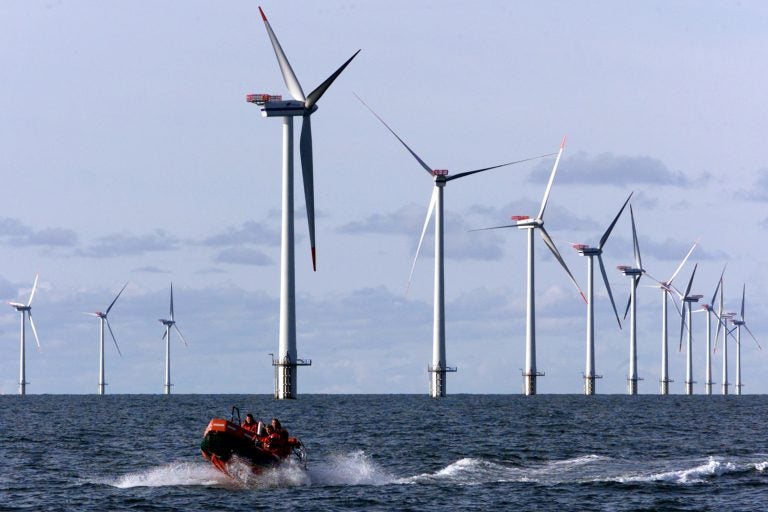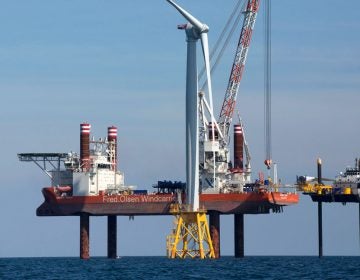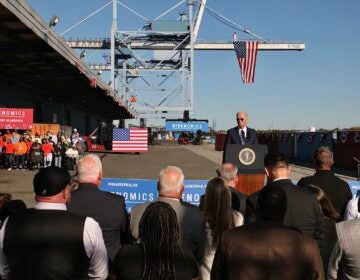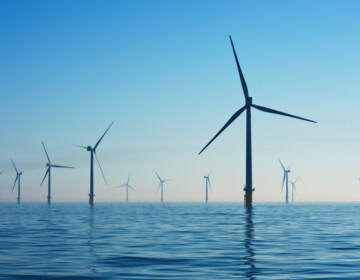Biden boosts offshore wind energy, wants to power 10M homes
Meeting the target could create jobs for more than 44,000 workers and employ nearly 33,000 others related to offshore wind activity, the White House said Monday.

(Heribert Proepper/AP Photo)
The Biden administration is ramping up efforts to sharply increase offshore wind energy along the East Coast, announcing progress on a huge wind farm planned off the New Jersey coast and setting a goal to generate enough power to provide electricity for more than 10 million homes by 2030.
Meeting the target could create jobs for more than 44,000 workers and employ nearly 33,000 others related to offshore wind activity, the White House said Monday. The effort also would help avoid 78 million metric tons of carbon dioxide emissions per year, a key step in the administration’s fight to slow global warming.
President Joe Biden “believes we have an enormous opportunity in front of us to not only address the threats of climate change, but use it as a chance to create millions of good-paying, union jobs that will fuel America’s economic recovery,” said White House climate adviser Gina McCarthy. “Nowhere is the scale of that opportunity clearer than for offshore wind.”
The administration’s commitment to the still untapped industry “will create pathways to the middle class for people from all backgrounds and communities,” she added.
Specifically, the administration said Monday it intends to prepare a formal environmental analysis for the Ocean Wind project off New Jersey, putting it in line to become the third commercial-scale offshore wind project in the U.S.
Ocean Wind, 15 miles off the coast of southern New Jersey, is projected to produce about 1,100 megawatts a year, enough to power 500,000 homes.
The Interior Department has previously announced environmental reviews for Vineyard Wind in Massachusetts and South Fork wind farm about 35 miles east of Montauk Point in Long Island, N.Y. Vineyard Wind is expected to produce about 800 megawatts of power and South Fork about 132 megawatts.
Biden has vowed to double offshore wind production by 2030 as part of his effort to slow climate change. The likely approval of the Atlantic Coast projects — the leading edge of at least 16 offshore wind projects along the East Coast — marks a sharp turnaround from the Trump administration, which stymied wind power both onshore and in the ocean.
As president, Donald Trump frequently derided wind power as an expensive, bird-slaughtering way to make electricity, and his administration resisted or opposed wind projects nationwide, including Vineyard Wind. The developer of the Massachusetts project temporarily withdraw its application late last year in a bid to stave off possible rejection by the Trump administration. Biden provided a fresh opening for the project soon after taking office in January.
“For generations, we’ve put off the transition to clean energy and now we’re facing a climate crisis,” said Interior Secretary Deb Haaland, whose department oversees offshore wind.
“As our country faces the interlocking challenges of a global pandemic, economic downturn, racial injustice and the climate crisis, we have to transition to a brighter future for everyone,” Haaland said.
Vineyard Wind is slated to become operational in 2023, with Ocean Wind following a year later.
The Interior Department’s Bureau of Ocean Energy Management said Monday it is establishing a new priority area for wind energy in shallow waters between Long Island and the New Jersey coast. A recent study shows the area can support up to 25,000 development and construction jobs by 2030, Interior said.
The ocean energy bureau said it will publish a proposed sale notice for the area, followed by a formal public comment period and a lease sale in late 2021 or early 2022.
Despite the enthusiasm, offshore wind development is still in its infancy in the U.S., far behind progress made in Europe. A small wind farm operates near Block Island in waters controlled by the state of Rhode Island, and another small wind farm operates off the coast of Virginia.
The three major projects under development are all owned by European companies or subsidiaries. Vineyard Wind is a joint project of a Danish company and a U.S. subsidiary of the Spanish energy giant, Iberdrola. Ocean Wind and South Fork are led by the Danish company, Orsted.
Wind developers are poised to create tens of thousands of jobs and generate more than $100 billion in new investment by 2030, “but the Bureau of Ocean Energy Management must first open the door to new leasing,″ said Erik Milito, president of the National Ocean Industries Association.
Not everyone is cheering the rise of offshore wind. Fishing groups from Maine to Florida have expressed fear that large offshore wind projects could render huge swaths of the ocean off-limits to their catch.

Get daily updates from WHYY News!
WHYY is your source for fact-based, in-depth journalism and information. As a nonprofit organization, we rely on financial support from readers like you. Please give today.




